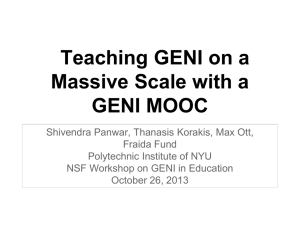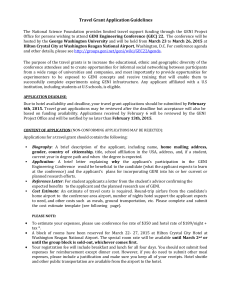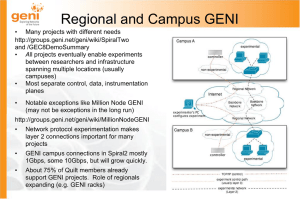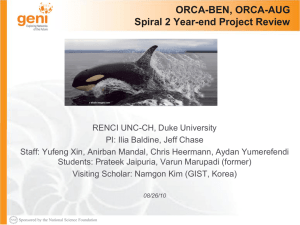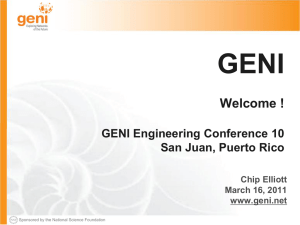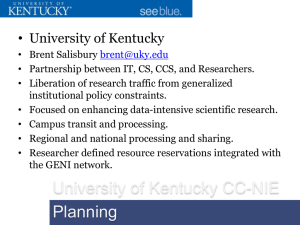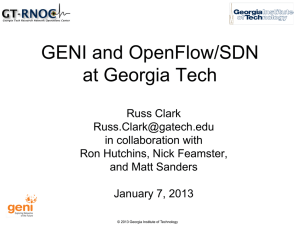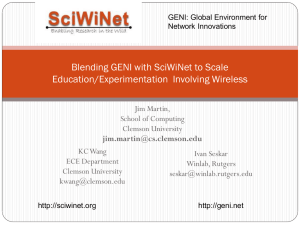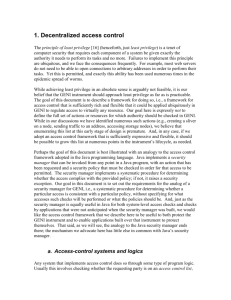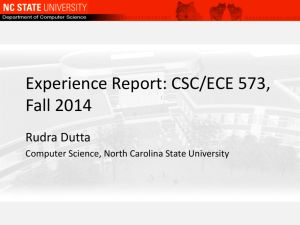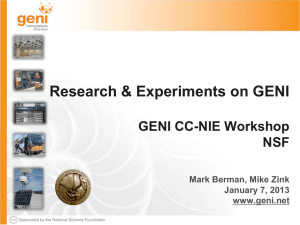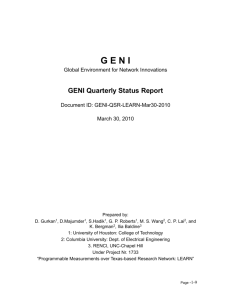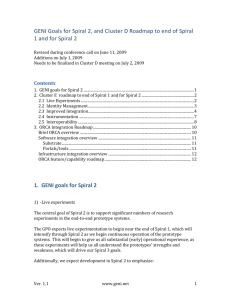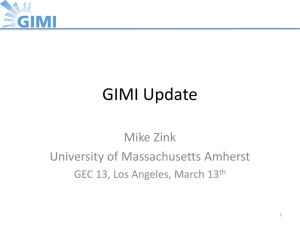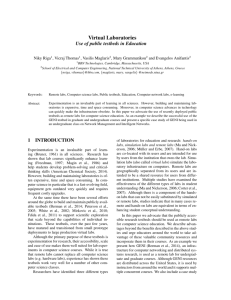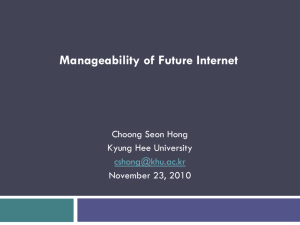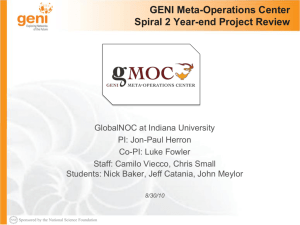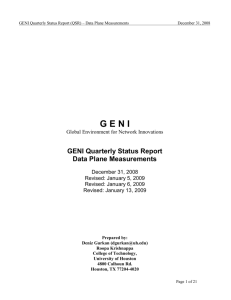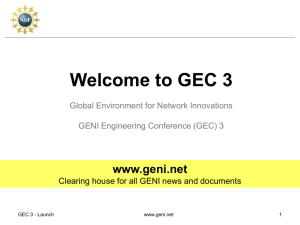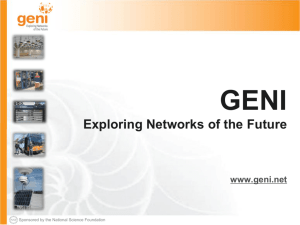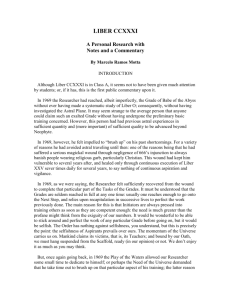Options and cost implications for GENI network connectivity
advertisement
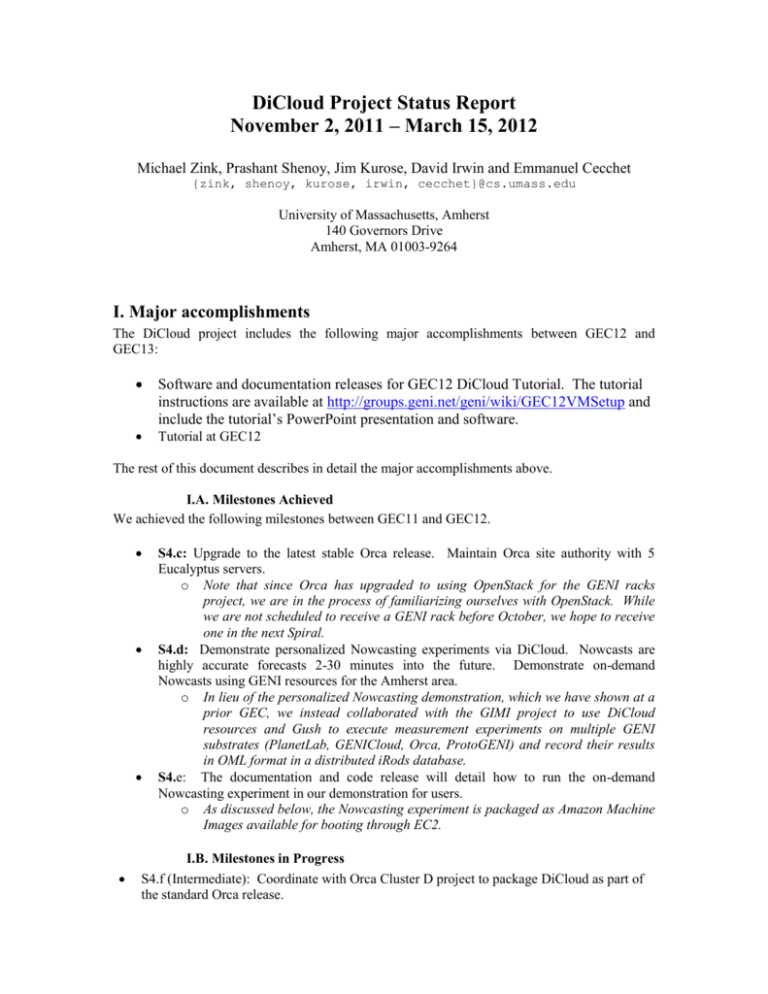
DiCloud Project Status Report
November 2, 2011 – March 15, 2012
Michael Zink, Prashant Shenoy, Jim Kurose, David Irwin and Emmanuel Cecchet
{zink, shenoy, kurose, irwin, cecchet}@cs.umass.edu
University of Massachusetts, Amherst
140 Governors Drive
Amherst, MA 01003-9264
I. Major accomplishments
The DiCloud project includes the following major accomplishments between GEC12 and
GEC13:
Software and documentation releases for GEC12 DiCloud Tutorial. The tutorial
instructions are available at http://groups.geni.net/geni/wiki/GEC12VMSetup and
include the tutorial’s PowerPoint presentation and software.
Tutorial at GEC12
The rest of this document describes in detail the major accomplishments above.
I.A. Milestones Achieved
We achieved the following milestones between GEC11 and GEC12.
S4.c: Upgrade to the latest stable Orca release. Maintain Orca site authority with 5
Eucalyptus servers.
o Note that since Orca has upgraded to using OpenStack for the GENI racks
project, we are in the process of familiarizing ourselves with OpenStack. While
we are not scheduled to receive a GENI rack before October, we hope to receive
one in the next Spiral.
S4.d: Demonstrate personalized Nowcasting experiments via DiCloud. Nowcasts are
highly accurate forecasts 2-30 minutes into the future. Demonstrate on-demand
Nowcasts using GENI resources for the Amherst area.
o In lieu of the personalized Nowcasting demonstration, which we have shown at a
prior GEC, we instead collaborated with the GIMI project to use DiCloud
resources and Gush to execute measurement experiments on multiple GENI
substrates (PlanetLab, GENICloud, Orca, ProtoGENI) and record their results
in OML format in a distributed iRods database.
S4.e: The documentation and code release will detail how to run the on-demand
Nowcasting experiment in our demonstration for users.
o As discussed below, the Nowcasting experiment is packaged as Amazon Machine
Images available for booting through EC2.
I.B. Milestones in Progress
S4.f (Intermediate): Coordinate with Orca Cluster D project to package DiCloud as part of
the standard Orca release.
S4.g (GEC14): Demonstrate Nowcasting experiment workflow using Gush-Orca-Dicloud
stack.
II. Deliverables Made
•
Deliverable S4.d has been made available in the form of Amazon Machine Images that
user can boot through EC2. The Amazon Machine Images for the Nowcasting experiment
are available as ami-a4d720cd and ami-bad621d3.
III. Description of Work Performed During Last Quarter
III.A. Activities and Findings
Between GEC12 and GEC13, we studied the efficacy of using the different GENI resources
available for real time scientific applications, such as Nowcasts. These resources included
GENICloud, PlanetLab, ProtoGENI, and Orca resources.
We ran extensive Nowcasting
experiments on each substrate to quantify the available bandwidth and latency (including its
jitter) to determine whether it can support a real-time Nowcasting application. We describe these
experiments in a paper at the GENI Research and Educational Experiment Workshop. They
should provide GENI researchers a good idea of what type of performance to expect out of the
platform today. Additionally, we used PlanetLab resources to model NEXRAD radar locations
and then experimented with a Nowcasting application between these resources and Amazon cloud
data centers (by using EC2, S3, and EBS). We report our findings in the technical report below,
CloudCast: Cloud Computing for Short-term Mobile Weather Forecasts, which is under
submission for publication to a conference. This work shows how appropriate GENI and today’s
cloud platforms are for this type of distributed real-time, mission-critical application. Finally, we
summarize the architecture for our cloud-based weather detection and warning system in a recent
short paper and poster at IGARSS 2012. In addition to our activities directly related to the
weather forecasting application on GENI (using Cloud resources), we also collaborated with the
GIMI project on a demonstration at GEC13 using DiCloud resources and Gush. The
demonstration used DiCloud resources (and resources on other GENI substrates) to run
bandwidth latency/measurement experiments between different nodes and then store them in a
distributed iRods database. We used Gush to get resources from the GENI substrates (via OMNI)
and script the startup of the experiment, which used an OML-enabled version of iperf. Thus, the
measurement data was structured as OML.
III.B. Project Participants
The primary PI is Michael Zink. Co-PIs are Prashant Shenoy, and Jim Kurose. Research Staff is
David Irwin and Emmanuel Cecchet. Dilip Kumar Krishnappa is a graduate student.
III.C. Publications (individual and organizational)
Dilip Kumar Krishnappa, Eric Lyons, David Irwin, Michael Zink. Compute Cloud Based
Weather Detection and Warning System. Proceedings of the IEEE International Geoscience and
Remote Sensing Symposium, Munich, Germany, July 2012.
Dilip Kumar Krishnappa, Eric Lyons, David Irwin, Michael Zink. Performance of GENI Cloud
Testbeds for Real Time Scientific Application. Proceedings of the First GENI Research and
Educational Experiment Workshop. Los Angeles, California, March 2012.
Dilip Kumar Krishnappa, Eric Lyons, David Irwin, Michael Zink. CloudCast: Cloud Computing
for Short-term Mobile Weather Forecasts. Technical Report, University of Massachusetts
Amherst, January 2012.
III.D. Outreach Activities
No outreach activities this quarter.
III.E. Collaborations
We collaborated with other Cluster D projects during the quarter. We provided feedback and
participated to discussions on the mailing list. We are actively consulting with the GUSH PI on
Omni and Orca integration with DiCloud.
